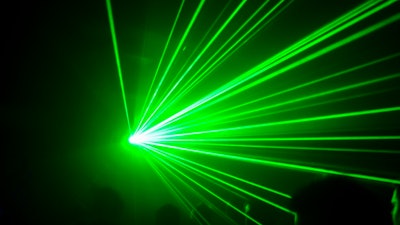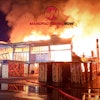
From simple laser pointers and barcode scanners to advanced laser marking systems and beyond, lasers are a versatile tool that can be used in diverse ways. However, their use in common applications does not mean they are always inherently safe.
Knowledge of lasers and their hazards can help prevent harmful accidents from occurring when utilizing them. To promote safety within your facility, we have compiled a variety of laser safety tips.
Safety Classifications
Per the standards and regulations developed by the Center for Devices and Radiological Health, each laser is ranked on a class basis depending on the risk it presents. The scale ranges from Class 1 to Class 4, and the classifications are distributed according to the risk associated with each laser.
- Class 1 – In Class 1, lasers are considered safe under all conditions of normal use. This includes low-powered lasers and high-powered lasers that are encapsulated within a unit. Examples of lasers in this class include those found in laptops or personal computers.
- Class 1M – The lasers in this category are deemed safe under normal conditions and use but are not safe to view through magnifying optics or telescopes.
- Class 2 – An example of a Class 2 laser is a presentation laser pointer or barcode reader. These lasers are deemed safe because of the human blink reflex, which prevents overexposure to the laser and eye damage.
- Class 2M – Lasers in this class meet the same requirements of Class 2. However, they are not safe to be viewed through optical tools, much like class 1M lasers.
- Class 3R – Class 3R encompasses low-powered lasers that should be handled with care. There is a maximum permissible exposure for this class, but the risk of injury is low.
- Class 3B – This class often includes medium-powered lasers that can cause damage to the naked eye with direct exposure. For this reason, safety goggles should be utilized when these lasers are in use.
- Class 4 – This class is comprised of the highest-powered and most dangerous lasers. Lasers in this class are unsafe for the skin and eyes, making proper protection essential. Class 4 lasers require more attention to safety, so precautions should be taken to complete projects.
To further describe the potential of lasers, the CDRH developed two classifications:
- Maximum permissible exposure – This describes the maximum level of laser radiation that individuals can tolerate before they face harmful physical effects to the eyes or skin. To make sure that laser radiation emitted is below the MPE, controls and regulations are instilled for participants to promote protection and reduce risk.
- Nominal hazard zone – For practicality and flexibility, most laser systems are not fully enclosed. For this reason, it is essential to create boundaries on the environment that indicate where there is potentially hazardous laser radiation. The indicated area is also known as the NHZ and controls are implemented to foster safety.
For example, employees must be properly trained and qualified to operate Class 3 and Class 4 lasers, which is established by appropriate courses and other requirements. These individuals are also in charge of creating a safe environment where only other qualified personnel are permitted in the area.
Working with lasers and equipment like laser marking systems can require careful preparation. While you should always use precautions when using any laser, the following steps are critical for Class 4 lasers. However, every step is worthwhile if it promotes safety for yourself and those around you. Start by preparing the room and gearing up. Then, check out additional safety tips and proper machine disposal, if applicable.
Laser Preparations
In order to make your project a success, maintenance and other precautions need to be followed. To prepare for your laser task, consider the following:
- Have a fire extinguisher nearby.
- Prepare for proper evacuation of fumes and smoke generated during the project.
- Unplug the machine when cleaning, maintaining, or servicing equipment between uses.
Personal protection is arguably one of the most important elements of laser safety, especially when working with lasers in Class 4. To prevent accidents and complete projects seamlessly, consider implementing the following:
- Eyewear safety – Be sure to have proper safety eyewear, and this eyewear can actually be purchased to match the wavelength of your laser to ensure adequate protection. Additionally, you should have a strap to keep the eyewear locked in place even with head movement. Lastly, eyewear should be stored properly to prevent scratches that can result in eye damage.
- Skin protection – Depending on the project and strength of your laser, your skin could be exposed to the harsh effects of the laser, leading to reddening, blistering, and charring. While these are almost always reversible or repairable, it is best to practice laser safety to prevent skin damage altogether.
- Warning signs – The use of prominent warning signs can promote safety throughout your facility. Posting signs outside of rooms where laser marking or other activities occur can warn your staff of the procedures and ensure they protect themselves before entering the premises. It is important to note that doors should never be locked while laser marking is in progress to ensure that a quick evacuation can be practiced in case of an emergency.
Additional safety tips to practice while using Class 4 lasers include:
- Avoid pointing the laser toward the entryway of a room.
- Seek assistance when cleaning or moving large machines.
- Use shields and barriers around the work area.
- Try to keep an unclosed beam out of the range of eye level.
- Ensure that locks do not prevent rapid evacuation.
- Consider using flashing signs outside of the project area that clearly indicate when a laser is operating.
Regardless of your industry or project, laser safety is of paramount importance. By being informed on your laser’s capabilities, practicing the necessary precautions, and hosting qualified individuals in the laser zone, you can maintain safety across your facility.
Julia Grosel works with TYKMA Electrox, a manufacturer of industrial laser marking systems that has been delivering quality laser marking, etching, and engraving solutions for over 55 years.






















